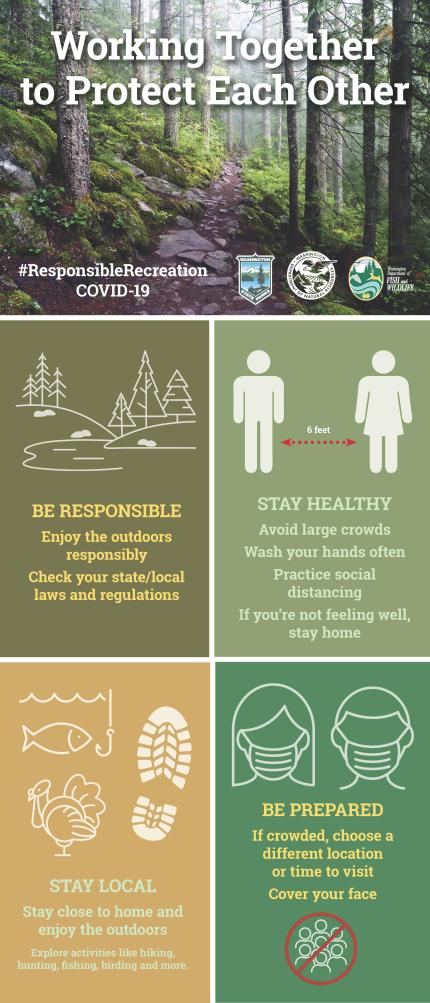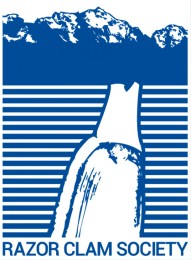
Month: May 2020
Razor Clam Update

[via email from Dan Ayres, Coastal Shellfish Manager, Washington Department of Fish & Wildlife] Emphasis editor’s own.
There will be no additional razor clam harvest openings until sometime in the fall of 2020. Conflicting information in local media reports and on various social media platforms has created some level of confusion.
Coastal Shellfish Manager, Washington Department of Fish and Wildlife, Region Six
The last few days, WDFW has been working with both Grays Harbor County and Pacific County regarding the possibility of allowing some razor clam harvest before the season ends on May 31. However, yesterday the Governor’s Office informed WDFW that because large razor clam crowds constitute a gathering under the Stay Home—Stay Healthy order. This order has been extended to May 31st, so razor clam digs and similar large gatherings are not allowed at this time.
WDFW is now focusing on a what we expect will be a great 2020-21 season and will start the field work for our summer-long razor clam population assessments very soon.
Call A Sturgeon
Editors Note: Washington State Department of Fish & Wildlife (WDFW) are really an amazing group of folks, and this press release clearly demonstrates why. Of particular interest is the fact that the White Sturgeon in Lake Roosevelt is in great abundance as a direct result of programs initiated by WDFW.
WDFW FISHING RULE CHANGE
Washington Department of Fish and Wildlife
1111 Washington St. SE, Olympia, WA 98501
https://wdfw.wa.gov/
May 19, 2020
Lake Roosevelt white sturgeon fishery
Action: Opens a harvest fishery for white sturgeon in Lake Roosevelt.
Effective date: Open 7 days per week beginning June 15, 2020 until further notice.
Species affected: White Sturgeon
Location: From Grand Coulee Dam to China Bend Boat Ramp (including the Spokane River from Highway 25 Bridge upstream to 400′ below Little Falls Dam, Colville River upstream to Meyers Falls Dam and the Kettle River upstream to Barstow Bridge)
Fishery Rules: Daily limit 1 sturgeon. Annual limit 2 sturgeon. It is legal to retain sturgeon between 50 inches and 63 inches fork length. Fork length is measured from the tip of the snout to middle of the fork in the caudal fin (tail). All harvested sturgeon must be recorded on a Catch Record Card (Catch Code 549). Two-pole fishing is allowed. Closed to night fishing. Anglers may continue to catch and release after obtaining a daily limit but must cease fishing after the annual limit has been taken. All other statewide rules for white sturgeon must be observed.
Anglers are asked to use heavy gear (50-lb. test mainline and leader at a minimum) and use 14/0 hooks or smaller to avoid catching and/or injuring large wild adult sturgeon. The request to use heavier gear will ensure anglers hook and land sturgeon effectively, but also is protective of large wild adult sturgeon that, if hooked, should be played to hand quickly and released without being removed from the water. WDFW recommends that any fish that will not be legally retained should not be removed from the water prior to release.
Reason for action: White Sturgeon hatchery programs began in 2001 in British Columbia (BC) and 2004 in Washington. Stocking ranged from 2,000-12,000 juvenile sturgeon per year from 2001 to 2010 (including both Washington and BC releases). Survival of hatchery-produced juvenile sturgeon was much higher than anticipated. As a result, there is a surplus of hatchery-origin sturgeon available for harvest from Lake Roosevelt.
Additional information: The Lake Roosevelt co-managers (WDFW, Spokane Tribe of Indians and the Confederated Tribes of the Colville Reservation) will all be conducting sturgeon fisheries. Non-tribal anglers are asked to be respectful of tribal angling, and both tribal and non-tribal sturgeon research that is occurring on the reservoir.
Anglers are reminded that fishery dates, times, slot limits, daily limits and annual limits may be adjusted over time to ensure that a sustainable population of sturgeon is maintained in Lake Roosevelt, as well as equitable access to the fishery amongst the three co-managers.
Information contact: For more information, contact Chris Donley, WDFW Region 1 Fish Program Manager (509) 892 1001 ext. 307 or Bill Baker, WDFW District 1 Fisheries Biologist (509) 563-5499.
Just for the Halibut
Note: Due to the truncated razor clamming season, we will be posting updates on alternative outdoor recreation activities such as fishing, oyster hunting, and gathering seaweed.
A Press Release from Washington Department of Fish & Wildlife (WDFW)
Puget Sound Halibut fishery to open for select dates starting May 20
OLYMPIA – The Washington Department of Fish and Wildlife announced today the expected dates of this year’s Puget Sound halibut fishing season, which was delayed due to the COVID-19 pandemic.

The halibut fishery will open in Marine Areas 5 through 10 beginning May 20 through June 30 on alternating days. The season structure was revised from what was originally planned to allow the halibut fishery to proceed in a manner that is consistent with the guidelines to limit travel. Anglers are encouraged to participate in these dates only if they can do so locally as part of a day trip, while also practicing physical distancing.
“In talking with public health officials and our partners at Washington’s ports, we think we’ve found a balance between being able to provide these opportunities and bring that value back into these communities, while also continuing to prioritize public health,” Larry Phillips, WDFW coastal region director. “These dates depend on anglers continuing to get outdoors responsibly – something we know folks can do because we’ve seen a lot of great examples of it these last couple of weeks.”
Anglers should only venture out well-prepared. WDFW is also recommending that people bring their own needs for personal hygiene; for example, hand washing materials, toilet paper, and face masks or bandanas. People are also reminded to be prepared to change plans if access sites are congested. Fishers are also reminded to check ahead to ensure that your intended access site is open and be aware of some local alternatives. Anglers should be aware that the Port of Neah Bay is closed to the public, there is no moorage or fuel available at that location.
Similar to last year, anglers fishing for halibut in Marine Area 6 will not be able to retain lingcod incidentally caught when fishing for halibut seaward of the 120-foot depth boundary. The depth restriction is designed to protect rockfish species, including yelloweye rockfish, which are listed under the federal Endangered Species Act (ESA).
However, lingcod retention will still be allowed seaward of the 120-foot depth restriction in Marine Area 5, which is outside of the area where yelloweye rockfish are listed.
In all marine areas open to halibut fishing, there is a one-fish daily catch limit and no minimum size restriction. Anglers may possess a maximum of two halibut in any form while in the field and must record their catch on a WDFW halibut catch record card. There is an annual limit of four halibut. Recreational fishery samplers will be available to collect catch information at fishing access sites throughout Puget Sound while practicing physical distancing guidelines.
Because halibut fisheries are managed to a quota, anglers should check the WDFW website to ensure a specific area is open prior to fishing. Complete information on recreational halibut regulations and seasons is available online at https://wdfw.wa.gov/fishing/regulations/halibut.
Season details are listed below.
2020 Puget Sound halibut seasons
- Marine Areas 5 – 10 will open May 20, 22, 24, 26, 28, 30, June 1, 3, 5, 7, 9, 11, 13, 15, 17, 19, 21, 23, 25, 27, 29.
- Puget Sound will be managed to an overall quota of 77,550 pounds as long as there is sufficient quota.
- Marine Areas 11, 12, and 13 will remain closed to halibut fishing to protect threatened and endangered rockfish species.
2020 Pacific Coast halibut seasons
- Marine Areas 1 – 4: will remain closed for now, WDFW will continue to work with public health officials and partners at coastal Washington ports to develop a halibut season opening plan for coastal marine areas.

In Case You Missed It….
Published on Apr 27, 2020
OLYMPIA –The Washington Department of Fish and Wildlife (WDFW) and Washington State Parks and Recreation Commission (Parks) announced today they will reopen state-managed lands on Tuesday, May 5, for local day-use only recreation.
The reopening will apply to state-managed parks, wildlife areas, recreation land, and boat launches. However, it may take several days for gates to be unlocked and sites to be serviced at remote areas due to limited staff capacity.
Some parks may not open immediately due to impacts on rural communities and the potential for crowding. State Parks is working with local communities and its partners to determine the best approach and timing to reopening these areas.
Visitor centers, camping, and other overnight accommodations on state-managed lands will remain closed until further notice.
The Department of Natural Resources (DNR) also plans to reopen their recreation lands on May 5 for day-use. [Note: as of May 13, camping remains closed. Check the link for specific regional openings & closures.]
State land managers recommend people come prepared and bring their own hand washing supplies, toilet paper, and personal protective equipment as some sites will have reduced or limited restroom facilities. People should also be prepared to change plans if their destination appears crowded or is not yet fully operational.
If sites become overcrowded or other COVID-19 related public safety concerns develop, state agencies may close areas with limited notice to further protect public health and safety. Certain restrictions around specific activities may also apply.
The public can find the latest information about WDFW and Parks operations at:

Before you go
- Check what’s open. While many state-managed land destinations are open for day-use, other local, tribal, and federal land may still be closed.
- Opt for day trips close to home. Overnight stays are not permitted.
- Stay with immediate household members only. Recreation with those outside of your household creates new avenues for virus transmission.
- Come prepared. Visitors may find reduced or limited restroom services as staff begin the process to reopen facilities at wildlife areas and water access sites. You are advised to bring your own soap, water, hand sanitizer, and toilet paper, as well as a mask or bandana to cover your nose and mouth.
- Enjoy the outdoors when healthy. If you have symptoms of fever, coughing, or shortness of breath, save your outdoor adventure for another day.
When you get there
- Avoid crowds. Be prepared to go somewhere else or come back another time if your destination looks crowded.
- Practice physical distancing. Keep six feet between you and those outside your immediate household. Launch one boat at a time to give others enough space to launch safely. Leave at least one parking space between your vehicle and the vehicle next to you. Trailer your boat in the same way.
- Wash your hands often. Keep up on personal hygiene and bring your own water, soap, and hand sanitizer with you.
- Pack out what you pack in. Take any garbage with you, including disposable gloves and masks.
